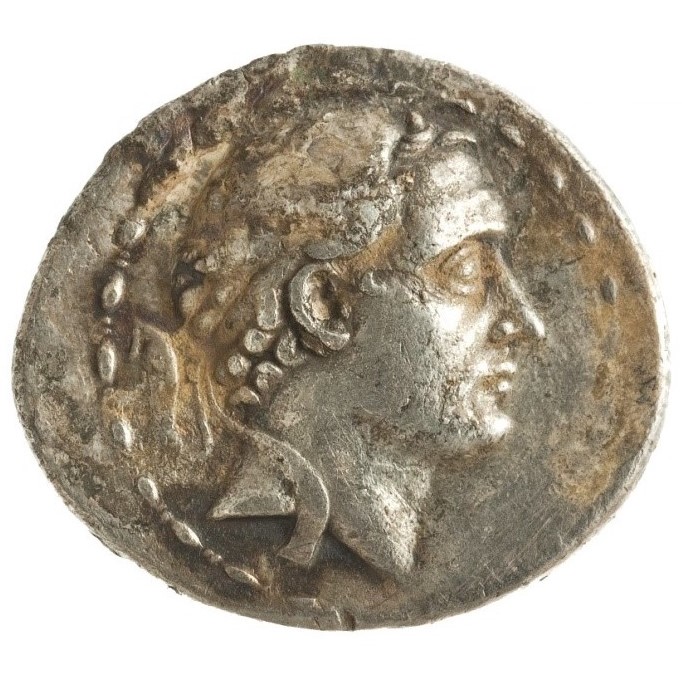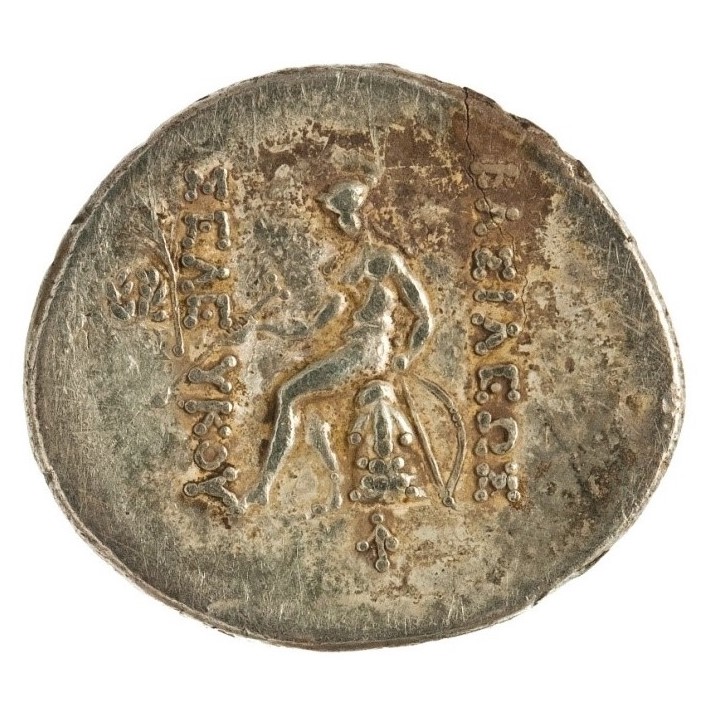Title: Tetradrachmon of Seleukos IV of Syria - 1968.12
Acquisition number: 1968.12
Author or editor: Douglas Kelly
Culture or period: Hellenistic.
Date: 187 - 175 BC.
Material: Metal - Silver
Object type: Coins - Greek
Dimensions: 33mm (w)
Origin region or location: Türkiye
Origin city: Antioch.
Display case or on loan: 5
Keywords: Coin, Greek, Hellenistic, Antioch, Syria, Seleukos IV, tetradrachmon, Apollo, Omphalos
A. Houghton, C. Lorber and O. Hoover, Seleucid Coins: A Comprehensive Catalogue, 2 vols (New York, Lancaster and London, American Numismatic Society and Classical Numismatic Group, 2002 and 2008), 1313.1.
O. Hoover, Handbook of Greek Coinage 13 vols (Classical Numismatic Group, Lancaster, PA, 2009-2013), 9 580e.
Classical Numismatic Group Auction, 450 lot 232.
N. Davis and C.M. Kraay, The Hellenistic Kingdoms: Portrait Coins and History (London, Thames and Hudson, 1973).
1968.12
Tetradrachmon of Seleukos IV of Syria
Silver. 16.63 g. 33 mm. 187-175 BC.
Obv.: Head of Seleukos IV r., diademed.
Rev.: Apollo seated l., on omphalos, naked, arrow in right hand, bow in left hand. To right, ΒΑΣΙΛΕΩΣ; to left ΣΕΛΕΥΚΟΥ (‘of King Seleukos’). In outer field, left, wreath and palm. In exergue, symbol ↑.
Antioch on the Orontes mint.
The Seleukid dynasty established itself in Syria after the death of Alexander the Great. Seleukos I had been one of Alexander’s generals. The Seleukid Empire was first centred on Babylon and claimed, with varying degrees of effectiveness, to rule all of Alexander’s vast eastern territories as well as the Near East, including Asia Minor.
In the latter part of the third century BC Seleukid control over Asia Minor was disrupted by rebellions and the rise of the kingdom of Pergamon. The Greek kingdom of Baktria (cf. 1966.72), located in present-day Afghanistan, had broken away and the eastern sections of the empire in present-day Iran had been taken over by usurpers. Antiochos III (Antiochos ‘the Great’, reigned 223-187 BC: cf. 1985.06) had recovered much of the lost territory in Asia Minor, Mesopotamia and further east and had extended Seleukid rule into Armenia. His defeat by the Romans in 188 BC, however, had weakened the kingdom by the loss of territory in Asia Minor, by the shattering of Seleukid prestige, and by a crushing war-indemnity of 15,000 talents of silver.
Antiochos III’s son, Seleukos IV, did his best to consolidate what was left of the kingdom, cultivating good relations with Rome as far as possible. Silver coinage of this Seleukos is fairly uncommon considering the length of his reign, since so much of the silver in the kingdom had to be sent to Rome, where it was converted to Roman denarii.
Apollo was the presiding deity of the Seleukid line, which claimed descent from him and which lavishly rebuilt and supported the temple of Apollo at Didyma near Miletos. The ‘seated Apollo’ coin-type had been standard on the coinage of Seleukid kings since Antiochos I (reigned 293-261 BC). The only exception is revealing: Seleukos II (reigned 246-226 BC) used a standing Apollo type, apparently because the seated Apollo was used by his brother, the rebel Antiochos Hierax, who claimed to be the legitimate ruler in Asia Minor. Note the seated Apollo on the coins of Antiochos III (1985.06) and Antiochos IV (1983.03). Later kings continued this coin type.
Omphalos, meaning ‘navel’, refers to various round objects. It often symbolises Delphi as the centre of the earth. The oracle at the temple of Apollo in Delphi was important for political as well as religious reasons. Seleukos’ father Antiochos III had been defeated by the Romans, whose leaders, e.g. Scipio Africanus, were now paying honour to sites such as Delphi. Seleukos’ interest in Delphi was probably diplomatic, as he attempted to maintain his contacts with the west.
A. Houghton, C. Lorber and O. Hoover, Seleucid Coins: A Comprehensive Catalogue, 2 vols (New York, Lancaster and London, American Numismatic Society and Classical Numismatic Group, 2002 and 2008), 1313.1.
O. Hoover, Handbook of Greek Coinage 13 vols (Classical Numismatic Group, Lancaster, PA, 2009-2013), 9 580e.
Classical Numismatic Group Auction, 450 lot 232.
N. Davis and C.M. Kraay, The Hellenistic Kingdoms: Portrait Coins and History (London, Thames and Hudson, 1973).

